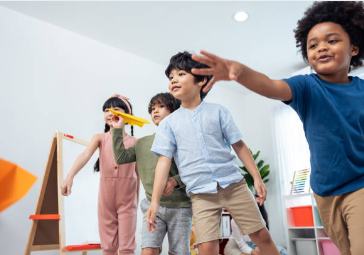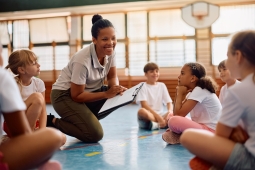Tips for Teaching Activities in a Small Space
February 13, 2020

Previously published in Volume 85, Issue 4
Being a health and physical education professional is rewarding, but it's also a career with challenges. We want to help our members connect and share the issues that come up in their classrooms so we can all learn from our collective experience.
Question:
What are your top 3 tips for teaching activities in a small space?
- Relays, Relays and more Relays – Use team relays with any skill or activity that you are teaching; relays give the students more room to perform and will also be much safer. The trick to running relays is to keep the students waiting in line active by playing music (dance), having exercises for them to perform or other fun challenges.
- Skill-Based Stations and Challenges – Stations are a great idea when using a small space with a lot of students; however, you need to make sure the students stay engaged and that the stations are skills that they have previously been taught. Some ideas are to make individual or team challenges so that students are encouraged to work together and help each other out to achieve a goal.
- Less is more – Don't use large amounts of equipment when teaching in a small space. Be creative and find multiple uses for minimal equipment. Teach activities that don’t require large equipment so that the space you are using seems bigger.
Neil Crockford | Éducation Physique, École Sage Creek School, Manitoba
- Technology – Utilize different modes of technology, such as projectors to show videos or gifs to assist students when there is minimal instructional space.
- Go Outside – There are so many activities and ways to teach skill progression outdoors even in the winter. Students love creativity and will thrive in different environments. This also promotes Physical Literacy and give students ideas about how they can stay active at home or during recess.
- Adapt Party Games – Quick, short activities that don’t require a lot of space or equipment. Some ideas include ping pong balls into cups, knocking pins off pylons with a frisbee or ball, Rock-Paper-Scissor games, and ladder golf.
Matt Gagné | Éducation Physique, École Sage Creek School, Manitoba
- Teamwork / Teambuilding Activities – Teach games and activities where students need to work together to accomplish different goals. This will minimize the equipment needed for students and encourage more cooperation between the students.
- Hallways / Classrooms – Use any area or space close to where you are teaching provided you can maintain adequate supervision of all students. Be flexible and creative in planning lessons with the space that you have.
- Walls / Benches / Other Obstructions – Floor tape is extremely useful in creating targets on walls for throwing and shooting activities. Use benches with floor tape for shuffleboard and beanbag sliding challenges. Recycle old measuring tapes by taping them onto benches for sit and reach testing or on the floor for standing long jump.
Daryl Fillion | Éducation Physique, École Sage Creek School, Manitoba
- Put your thinking cap on – The first step is to brainstorm places in your school you can use when your gym is unavailable. My go-to places include the stage, library, cafeteria, the lobby, and classrooms.
- Take extra precautions – Safety always comes first. You need to make sure your space is safe for the activity you have planned. I do move tables, desks, and chairs to the side depending on the activity. Usually, the classroom teacher helps me out in this situation and they love seeing what I do as they are open to ideas that they can do with their students. A lot of my small space activities focus on health-related physical fitness.
- Look online – Lately, my best go-to for activities for small places is BOKS bursts. They have wonderful yoga, dance and classroom activities and a great resource of YouTube videos. Sign up today! www.bokskids.ca/
Selena Davidson Eno | PHE Teacher, Bayview Community School, Nova Scotia








